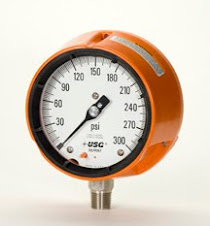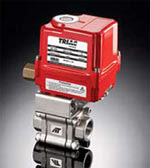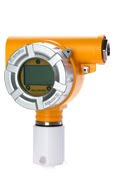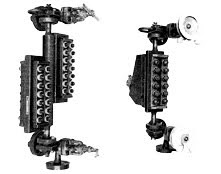Open Channel Flowmeters
How Open Channel Flowmeters Work
Open channel flowmeters measure the flow of liquids that are open to the atmosphere at some point in the measurement system. The liquid may be entirely open to the atmosphere, or may be contained within a closed pipe that is not full of liquid and only open to the atmosphere at the flowmeter itself.
Open channel flowmeters generally consist of a primary device, transducer, and transmitter. The wetted primary device restricts the liquid flow stream. Under flowing conditions, this restriction causes a rise in liquid level at a location either upstream or within the flowmeter. When the flow increases, the level rises higher. A transducer is mounted on or near the primary device to sense the level. The electronic transmitter uses the signal from the transducer to measure the level to determine liquid flow.
Different geometries are used for open channel measurement, including flumes that make the channel narrower, weirs that force the liquid over a dam-like obstruction, and nozzles that restrict the flow of liquid before it freefalls from the nozzle.
How to Use Open Channel Flowmeters
Open channel flowmeters measure the flow of liquids that can be safely exposed to the atmosphere, such as water and sewage. Applications for these flowmeters are primarily found in the water and wastewater industries to measure water and sewage flows. However, there are usually a few applications for open channel flowmeters to measure effluent flows in the mining, mineral processing, power, pulp and paper, petroleum, chemical, and petrochemical industries. Due to the limited applicability of open channel flowmeters, materials of construction are typically limited to those that target these applications. Sizes range from a few inches to tens of feet. It is generally less expensive to purchase smaller open channel flowmeters and field construct larger ones (typically with concrete).
Application Cautions for Open Channel Flowmeters
Open channel flowmeters pose potential environmental and safety issues because the liquid is exposed to the environment. Also, dirt can accumulate and plug the sensing systems of some designs. Dirt can also adversely affect the accuracy of these flowmeters.
A straight run of channel is usually installed upstream of the primary device to condition the flow to be free of jetting and eddies. The channel should properly mate with the flowmeter and not create any abrupt dimensional changes at the transition. Be careful when designing the channel downstream of the flowmeter because some open channel flowmeters require free-fall conditions, whereas others require a downstream channel.
When installing the primary device, be sure to level the flowmeter per manufacturer specification in all planes. Make sure that the transducer is mounted in the correct location because failure to do so can cause erroneous flow measurements.
Tuesday, June 22, 2010
Tuesday, June 1, 2010
Pressure Gauges being a very simple device have some complexities.
To address these complexities Ron Williams at Ametek US Gauge
To address these complexities Ron Williams at Ametek US Gauge
has written the following white paper on Ametek US Gauge,
I hope you find it interesting.
SUPERIORITY OF SEAMLESS
BOURDON TUBE IN PRESSURE
GAUGE APPLICATION
By Ron Williams, Sr. Design Engineer, PE &
Gordon Sun, Product Manager, CQE/CQM
An AMETEK US Gauge White Paper
Introduction
Pressure tubing requires an uncompromising level of quality
because of the critical end-use applications. In petrochemical
and refining facilities often there are presences of highly
corrosive and even lethal process media being produced,
processed, or transported. Because of severe environmental
impact in case of potential rupture, tubes and pipes are
almost always specified to be seamless to offer the highest
level of assurance of safety.
At AMETEK U.S. Gauge we consider the Bourdon Tube an
integral part of the piping and tubing system. Therefore, if
specification requires pipes and tubes to be seamless, then
why would you consider anything else but U.S. Gauge, the
only process gauge brand manufactured with seamless
Bourdon Tube in the marketplace?
Weakness of Welded Bourdon Tube Design Due to economic
SUPERIORITY OF SEAMLESS
BOURDON TUBE IN PRESSURE
GAUGE APPLICATION
By Ron Williams, Sr. Design Engineer, PE &
Gordon Sun, Product Manager, CQE/CQM
An AMETEK US Gauge White Paper
Introduction
Pressure tubing requires an uncompromising level of quality
because of the critical end-use applications. In petrochemical
and refining facilities often there are presences of highly
corrosive and even lethal process media being produced,
processed, or transported. Because of severe environmental
impact in case of potential rupture, tubes and pipes are
almost always specified to be seamless to offer the highest
level of assurance of safety.
At AMETEK U.S. Gauge we consider the Bourdon Tube an
integral part of the piping and tubing system. Therefore, if
specification requires pipes and tubes to be seamless, then
why would you consider anything else but U.S. Gauge, the
only process gauge brand manufactured with seamless
Bourdon Tube in the marketplace?
Weakness of Welded Bourdon Tube Design Due to economic
reasons, the majority of pressure gauge manufacturers use
welded tubing to form into Bourdon Tube...
1.Even if manufactured to strict production standards
and procedures that allow these welded tubing to meet the
precise ASTM/ASME specifications required for pressure
vessels, there are still numerous disadvantages inherent in
the welded Bourdon Tubes. Among these key disadvantages
are
and procedures that allow these welded tubing to meet the
precise ASTM/ASME specifications required for pressure
vessels, there are still numerous disadvantages inherent in
the welded Bourdon Tubes. Among these key disadvantages
are
1) welding heat-affected zones,
2) susceptibility to crevice corrosion,
3) non-homogeneity in grain structures,
4) costly testing to ensure weld integrity, and
5) careful orientation of weld seam away from high stress areas.
It is for these reasons that the ANSI/ASME codes derate the
strength of welded tube to 85% that of seamless tube
strength of welded tube to 85% that of seamless tube
2.The codes provide that welded tube rated equal to the strength of
seamless tube must be 100% radiographically inspected.
1 Based on AMETEK USG competitive benchmarking research
seamless tube must be 100% radiographically inspected.
1 Based on AMETEK USG competitive benchmarking research
conducted in 2005
2 ANSI/ASME Boiler and Pressure Vessel Code, Section VIII,
2 ANSI/ASME Boiler and Pressure Vessel Code, Section VIII,
Division I, Table UHA-23, Page 162
AMETEK USG Advantage
AMETEK USG has over 100-years of experience of
manufacturing Bourdon Tubes and pressure gauges, and
understands that the “heart” of a pressure gauge is its
Bourdon Tube. This is the reason USG uncompromisingly
AMETEK USG has over 100-years of experience of
manufacturing Bourdon Tubes and pressure gauges, and
understands that the “heart” of a pressure gauge is its
Bourdon Tube. This is the reason USG uncompromisingly
stayed with the seamless Bourdon Tube design even as
stainless steel raw material cost is ever increasing. There
is no substitution for safety. Seamless Bourdon Tube offers
numerous advantages that make it superior to our competition.
Advantage 1
Seamless Bourdon Tube is without heat-affected zone.
The welded tube heat-affected zone possesses an altered
metallurgy to that of the base metal. The welding process
can transform the local microstructure increasing grain size
when heated and producing stresses between the heat
effected zone and the base metal that promote cracks on
cooling.
Advantage 2
Seamless Bourdon Tube has superior resistance to
corrosion. An incomplete welding process, however minute
can leave microscopic gaps that provide entry for corrosive
contaminates and stress risers that in time could lead to the
failure of the weld seam. This is also known as crevice corrosion.
Crevice corrosion is the result of the accumulation of foreign
material in crevices that are created on the surface of the
stainless steel component. Among the different kinds of
corrosion that stainless steel can be susceptible to, crevice
corrosion is one of the most common types, which usually
occurs in joints, cavities, holes, grooves, gaskets, and gaps of
any stainless components. Conditions that cause stainless
crevice corrosion, (including very high temperatures) can
totally degrade the entire surface of the stainless steel
component, which in turn would make the steel vulnerable to
oxidation or rusting.
Advantage 1
Seamless Bourdon Tube is without heat-affected zone.
The welded tube heat-affected zone possesses an altered
metallurgy to that of the base metal. The welding process
can transform the local microstructure increasing grain size
when heated and producing stresses between the heat
effected zone and the base metal that promote cracks on
cooling.
Advantage 2
Seamless Bourdon Tube has superior resistance to
corrosion. An incomplete welding process, however minute
can leave microscopic gaps that provide entry for corrosive
contaminates and stress risers that in time could lead to the
failure of the weld seam. This is also known as crevice corrosion.
Crevice corrosion is the result of the accumulation of foreign
material in crevices that are created on the surface of the
stainless steel component. Among the different kinds of
corrosion that stainless steel can be susceptible to, crevice
corrosion is one of the most common types, which usually
occurs in joints, cavities, holes, grooves, gaskets, and gaps of
any stainless components. Conditions that cause stainless
crevice corrosion, (including very high temperatures) can
totally degrade the entire surface of the stainless steel
component, which in turn would make the steel vulnerable to
oxidation or rusting.
Advantage 3
Seamless Bourdon Tube has homogeneous grain
structure. Welded tube requires a secondary localized cold
work applied to the weld seam (bead working). Cold working
imparts homogeneity to the grain structure improving
corrosion resistance. Improper bead working can lead to
uneven cold work, discontinuities or laps causing premature
failure at the weld. For seamless Bourdon Tube there is no
need for this secondary process to homogenize irregular postwelding
grain structure.
Advantage 4
Seamless Bourdon Tube does not require costly tests
to ensure weld integrity. Where safety and reliability is of
paramount concern because of high pressures or hazardous
materials, it is recommended that the tube receive additional
non-destructive examination to ensure the weld integrity.
Seamless Bourdon Tube offers the superior security and
assurance because there is no weld integrity to concern
about.
Advantage 5
Seamless Bourdon Tube does not require difficult
weld seam orientation in pressure gauge
manufacturing processes. In applications such as a
Bourdon Tube, the weld seam must be located and marked
prior to any additional cold work to prevent the seam from
being located in a highly stressed area during tube flattening
and coiling. If improperly done the weld might be subjected
to stresses approaching yield. Any microscopic imperfections
may produce stress concentrations in excess of its strength
limits, making it susceptible to corrosion.
In almost all cases, the welded seam is visually
indistinguishable after polishing and successive drawing
operations, making the task of properly aligning and
orienting virtually impossible when forming and coiling the
Bourdon Tube.
Advantage 6
Seamless Bourdon Tube does not require pressure
derating or secondary inspection for hazardous and
critical applications. It is for reasons cited above that the
ANSI/ASME codes derate the strength of welded tube to 85%
that of seamless tube. With the seamless Bourdon Tube
design, AMETEK USG process gauges have the highest
overall tested and published burst pressures in the industry.
Seamless Bourdon Tube has homogeneous grain
structure. Welded tube requires a secondary localized cold
work applied to the weld seam (bead working). Cold working
imparts homogeneity to the grain structure improving
corrosion resistance. Improper bead working can lead to
uneven cold work, discontinuities or laps causing premature
failure at the weld. For seamless Bourdon Tube there is no
need for this secondary process to homogenize irregular postwelding
grain structure.
Advantage 4
Seamless Bourdon Tube does not require costly tests
to ensure weld integrity. Where safety and reliability is of
paramount concern because of high pressures or hazardous
materials, it is recommended that the tube receive additional
non-destructive examination to ensure the weld integrity.
Seamless Bourdon Tube offers the superior security and
assurance because there is no weld integrity to concern
about.
Advantage 5
Seamless Bourdon Tube does not require difficult
weld seam orientation in pressure gauge
manufacturing processes. In applications such as a
Bourdon Tube, the weld seam must be located and marked
prior to any additional cold work to prevent the seam from
being located in a highly stressed area during tube flattening
and coiling. If improperly done the weld might be subjected
to stresses approaching yield. Any microscopic imperfections
may produce stress concentrations in excess of its strength
limits, making it susceptible to corrosion.
In almost all cases, the welded seam is visually
indistinguishable after polishing and successive drawing
operations, making the task of properly aligning and
orienting virtually impossible when forming and coiling the
Bourdon Tube.
Advantage 6
Seamless Bourdon Tube does not require pressure
derating or secondary inspection for hazardous and
critical applications. It is for reasons cited above that the
ANSI/ASME codes derate the strength of welded tube to 85%
that of seamless tube. With the seamless Bourdon Tube
design, AMETEK USG process gauges have the highest
overall tested and published burst pressures in the industry.
Summary
What is the cost of a hazardous material spillage and its
clean up? What is the cost of shutting down and starting up
a process? What is the cost of negative publicity on the 6
o’clock evening news? What is the cost to environmental
impact? AMETEK USG understands that there is always an
eventual price to pay for using inferior product.
The best advantage of all? AMETEK USG process gauges,
with the Seamless Bourdon Tube, are price competitive with
“lesser” process gauges. You are getting superior reliability
and performance for free!
Test data, based on actual minimum rupture pressures observed,
What is the cost of a hazardous material spillage and its
clean up? What is the cost of shutting down and starting up
a process? What is the cost of negative publicity on the 6
o’clock evening news? What is the cost to environmental
impact? AMETEK USG understands that there is always an
eventual price to pay for using inferior product.
The best advantage of all? AMETEK USG process gauges,
with the Seamless Bourdon Tube, are price competitive with
“lesser” process gauges. You are getting superior reliability
and performance for free!
Test data, based on actual minimum rupture pressures observed,
available from AMETEK USG upon request. The best advantage
of all? … you are getting superior reliability and performance for
FREE!
USG Process Gauges are Proudly Made in the U.S.A.
of all? … you are getting superior reliability and performance for
FREE!
USG Process Gauges are Proudly Made in the U.S.A.
Subscribe to:
Comments (Atom)




















